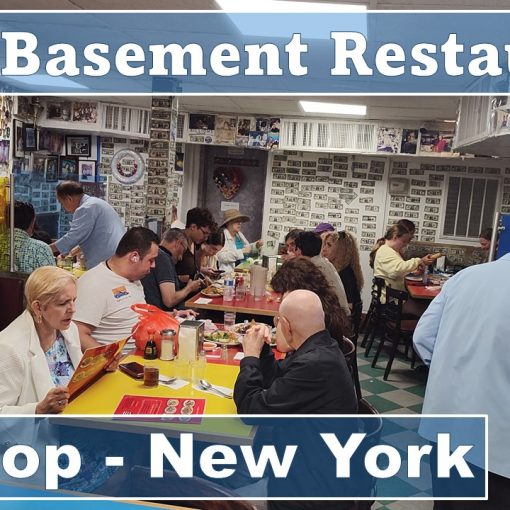John Lennon is known for his song writing partnership alongside Paul McCartney in their rock quartet, The Beatles. Later, John and his second wife, Yoko Ono, recorded songs together. Two of Lennon’s well-known favorites are “Imagine” and “Give Peace a Chance.” These songs reached far into the political vista and are still prevalent today.

A verse from “Imagine” released in 1971 still holds power today.
Tragically, at 40 years old, John Lennon’s life was cut short by four bullets. As John Lennon’s 85th Birthday approaches on October 9th, let’s take a moment to “Imagine” and “Give Peace A Chance.” Were you aware that this peace-making poet spent years under government surveillance? Join us as we examine John Lennon’s message, the importance of October 9th and visit to his Central Park memorial, “Strawberry Fields.”
Revolution
As the Vietnam War raged in 1968, The Beatles had released the song, “Revolution.” During an interview at The National Theatre, John Lennon stated firmly, “I think our society is run by insane people for insane objectives.” These strong words made John Lennon a controversial public figure. President Richard Nixon had made extended efforts to constantly monitor and attempt to deport John Lennon.
Chicago Protest March
During an anti-war demonstration a Chicago television crew filmed as officers brought down billy clubs on peaceful protesters. The crowd began to chant, “The Whole World Is Watching! The Whole World Is Watching!”
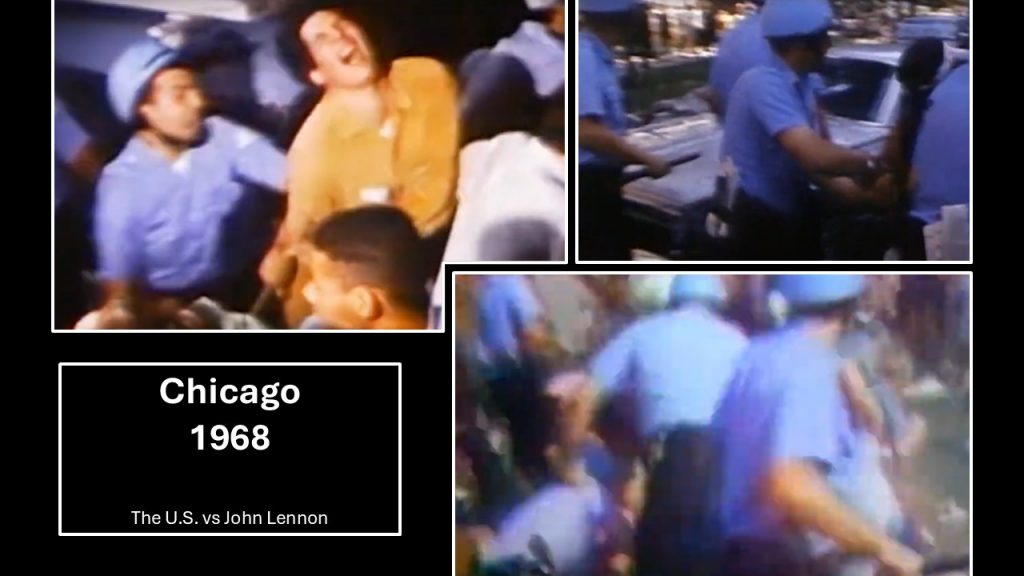
In response John Lennon encouraged the public to take note of these happenings and stated, “You have to be more politically aware of it. In this day and age of it. It’s almost impossible to close your eyes to it.”
U.S. Senator George McGovern had stated, “The Vietnam War divided this country as it had not been divided since the Civil War.”
“Bed – In” 1969
Knowing the press would follow them on their honeymoon, John and Yoko Ono chose to spend the week in bed as a peaceful protest, “Bed – In.” During an interview, where the couple was cozy under blankets, John said, “When it comes down to using violence, then you’re playing the system’s game.” John had pointed out, “Once they’ve got you violent, then they know how to handle you.”
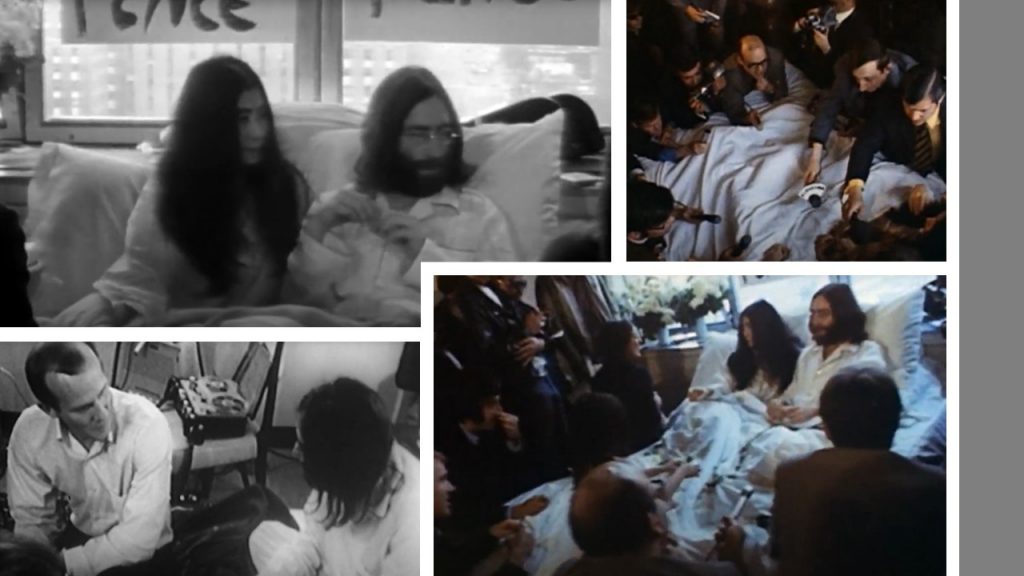
Photo Credit: The U.S. vs John Lennon Documentary
From their bed John Lennon, Tommy Smothers and Yoko Ono led a group in the live recording of the song, “Give Peace A Chance.”
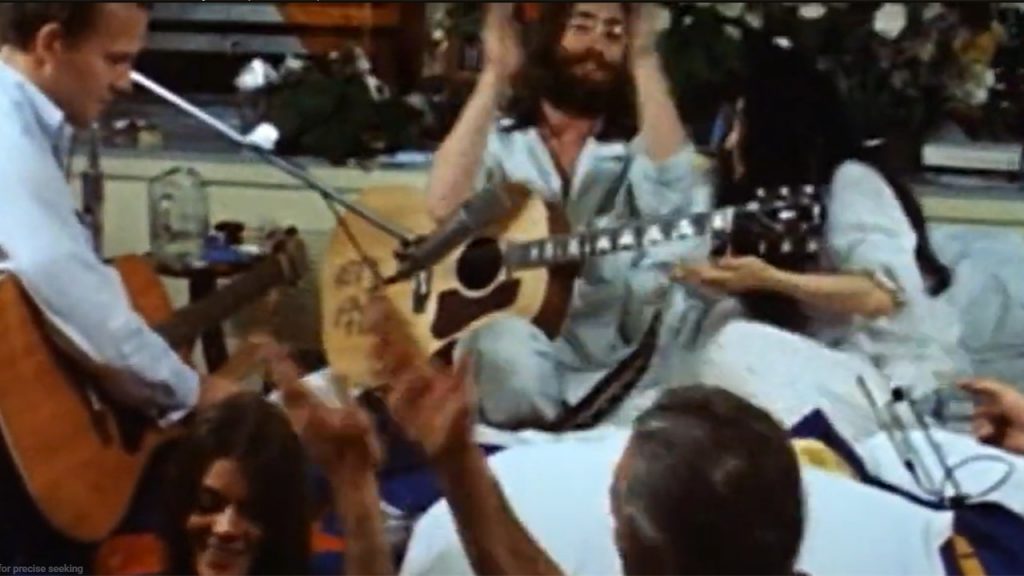
Photo Credit: The U.S. vs. John Lennon Documentary
The Washington D.C. Protest
In 1969 over a million people gathered serenely around Washington D.C. They raised their voices as one repeating, “All we are saying is give peace a chance.” Encouraging law makers and the President to end the Vietnam War. This song became the anthem of the anti-war effort.

John Dean, White House Council, reported, “Nixon would put out the line that during these demonstrations he was watching a football game or something like that. But he was very concerned with the demonstrations.” John Dean shook his head and closed his eyes, “They were making a definite impact inside the White House.”
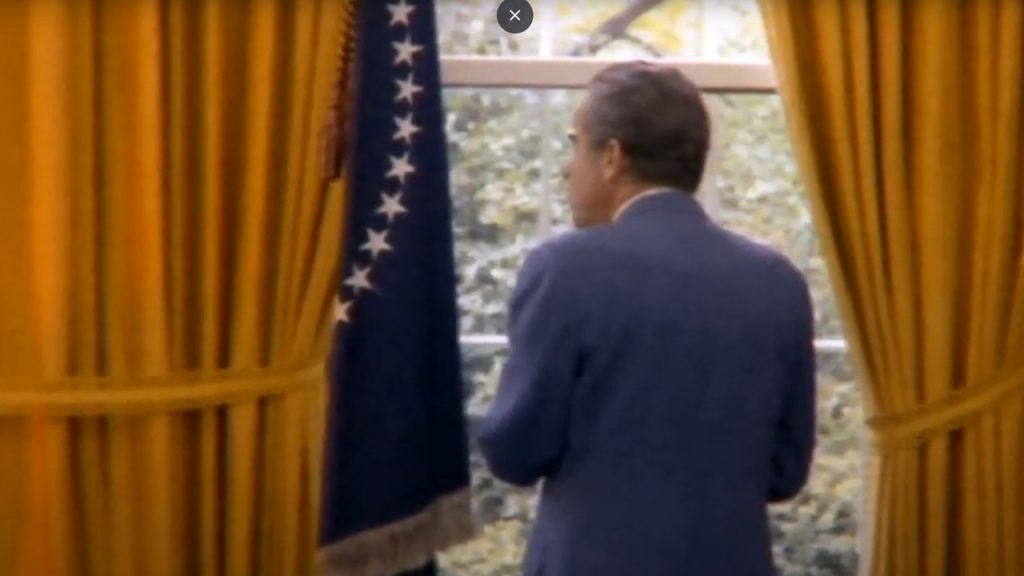
Photo Credit: The U.S. vs. John Lennon
In April 1970 President Nixon ordered the bombing of Cambodia. People were enraged, especially on college campuses. The President called in the National Guard to patrol United States’ cities.
Four Student Demonstrators Killed By The National Guard
On May 4, 1970 four student demonstrators were killed at Kent State University in Ohio.
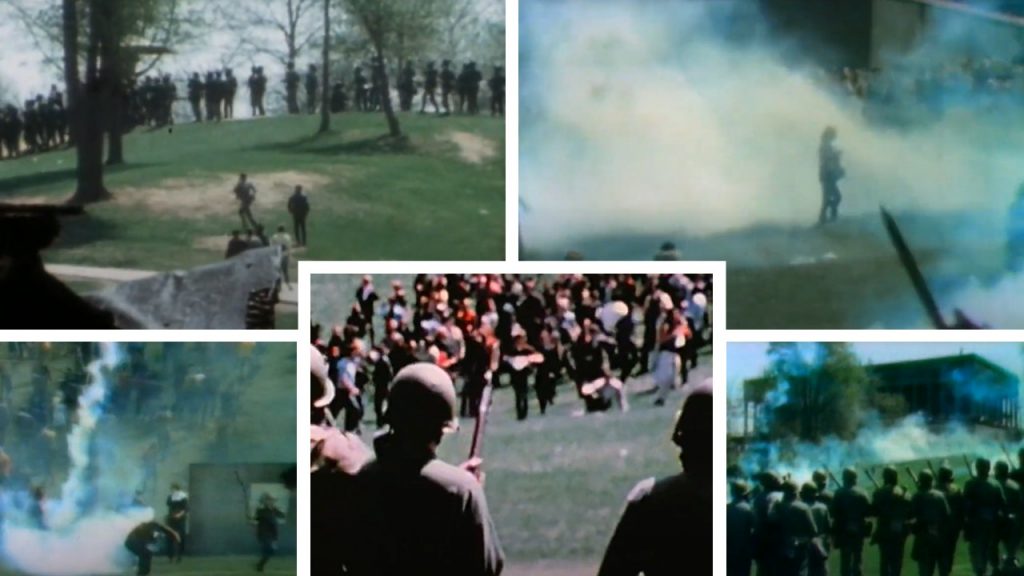
Photo Credit: The U.S. vs. John Lennon Documentary
G. Gordon Liddy, former Nixon Administration Official recalled, “You had eighteen year old college kids without the sense God gave a goose, going around challenging eighteen year old kids who had 30 yacht 6, semi-automatic weapons. Yes. They were in uniform, but with very little training. They felt threatened. They were armed. What did you think was going to happen?”
President Nixon’s Re-Election Campaign
President Nixon began his re-election campaign in January 1972. He stated that he had a plan, which he’d reveal after the election, to end the Vietnam War peacefully.
John Lennon started to arrange a concert tour which would follow the 1972 Republican national convention around the country. Richard Nixon and his right-leaning Republican party began to feel threatened by this song writer and political activist. You see, in July of 1971 the 26th Amendment was ratified, giving eighteen year old Americans the right to vote.
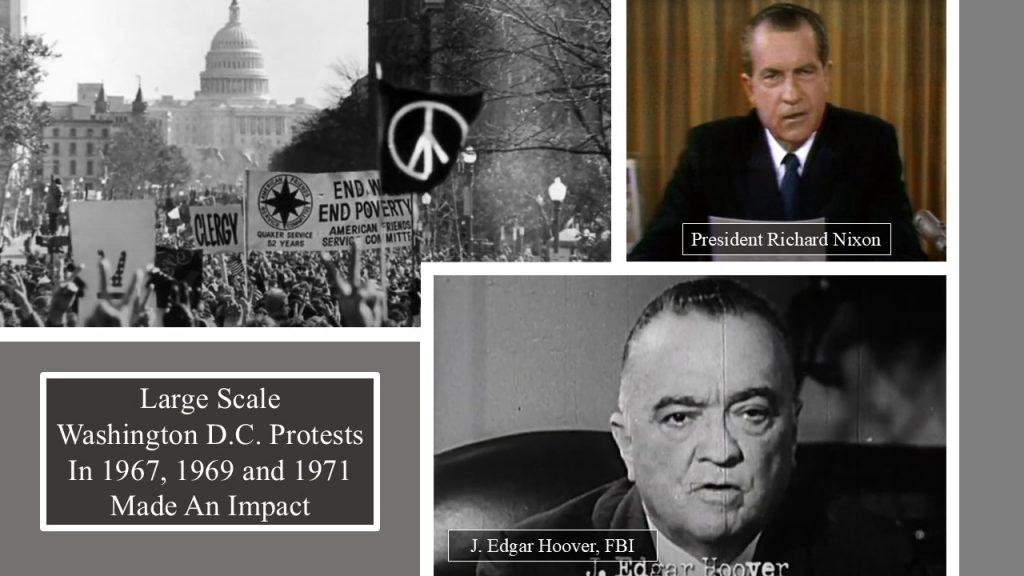
Surveillance And Deportation Proceedings
John Lennon reported that he knew he was being watched. “They would be standing across the street, then they’d follow me wherever I went.” His phones made a rustling static, leading him to believe that someone was listening to his conversations.
G. Gordon Liddy, former Nixon Administration Official, admitted, “He (John Lennon) was a high profile figure, so his activities were being monitored.”
Strom Thurmond, U.S. Senator, wrote in a letter, ” . . . If Lennon’s Visa is terminated, it would be a strategy counter-measure.”
In February 1972 a knock came at John and Yoko’s door, “Immigration!” The couple refused to let the person inside, so a letter was slid under the door. “Your temporary stay in the United States as visitors has expired on February 29, 1972. It is expected that you will effect your departure from the United States on or before March 15, 1972.” Later in an interview, Yoko Ono had said, “It was a very frightening moment.”
On March 16th John and Yoko Ono appeared in court. Outside John told a reporter,”I feel like I’m in school again. You know I’ve been in trouble all me life, one way or the other. I’m back seeing the head (master). This time they don’t cane me. That’s all. They don’t beat me anymore.”
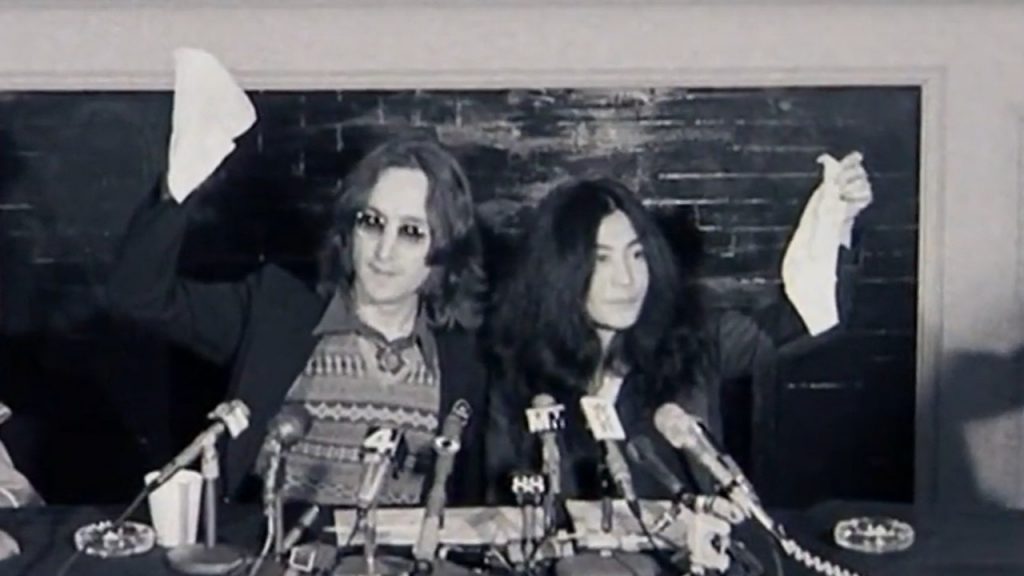
Photo Credit: The U.S. vs John Lennon Documentary
Hearings, court appearances and investigations continued but without enforcing deportation.
Once Nixon won the 1972 election, pressures on the Lennons quieted from the White House, however the immigration department continued to run inquiries over the next eighteen months.
The Wall Street Journal chimed in and published an editorial on March 28,1973. “We find it more than a little hard to believe that authorities could find no legal way to resolve what is, after all, a highly unusual set of circumstances. Further we submit that if the law does not reflect the human equities, it is a law that needs to be changed.”
Counter Suits – Leon Wildes
Leon Wildes, Lennon’s immigration attorney, filed counter suits against John’s accusers. Wildes said, “Deep in John’s immigration file, which was a high security file, were documents reaching all the way up to President Nixon, showing improper interference in an immigration case and pre-judgement.”
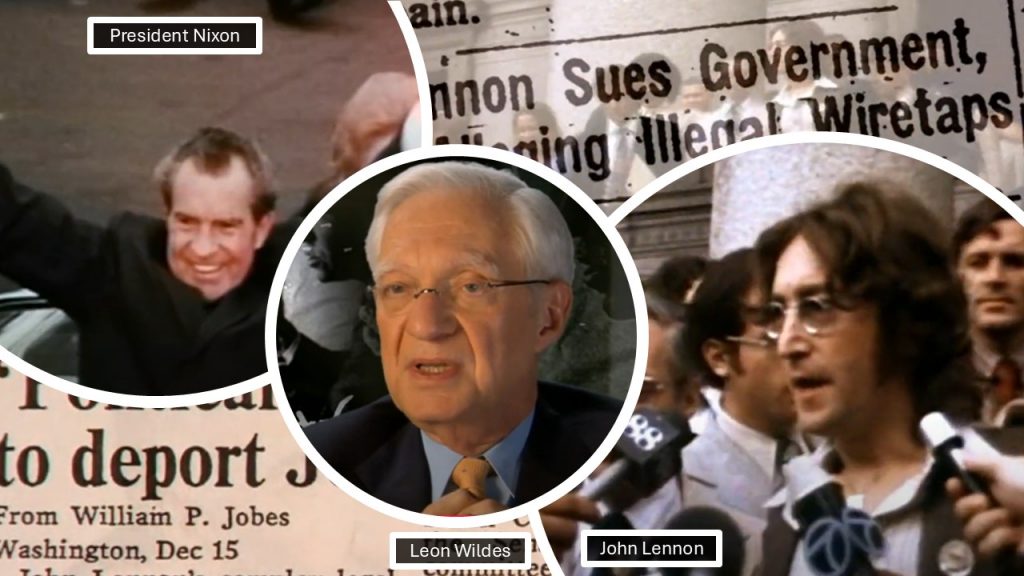
Photo Credit: The U.S. vs. John Lennon
Mario Cuomo, Governor of New York 1983-1995, said, “The case of John Lennon by the FBI, the Immigration and Naturalization Service and President Nixon and all his people was that John Lennon was disloyal to the United States of America and what it stood for.” Cuomo continued, “The real disloyalty was Nixon’s, Hoover’s, the INS and all the peoples who were all implicated, and the FBI and the INS and wherever else, because their perversion, distortion of The Constitution. Their violation of the basic principles. That was the greatest disloyalty.”
During the four and a half years of proceedings, John Lennon continued to write and performed songs. One of these was poignantly titled, “Just Gimme Some Truth.”
October 9, 1975
Leon Wildes, the immigration lawyer, called John Lennon on October 9, 1975, which happened to be John’s birthday, to say, “We won!” The Immigration Court of Appeals had approved John Lennon’s Alien Green Card. (which actually happened to be blue)
Overjoyed, John replied, “I have a beautiful boy!” Sean had just been born, sharing his birthday with his Dad.
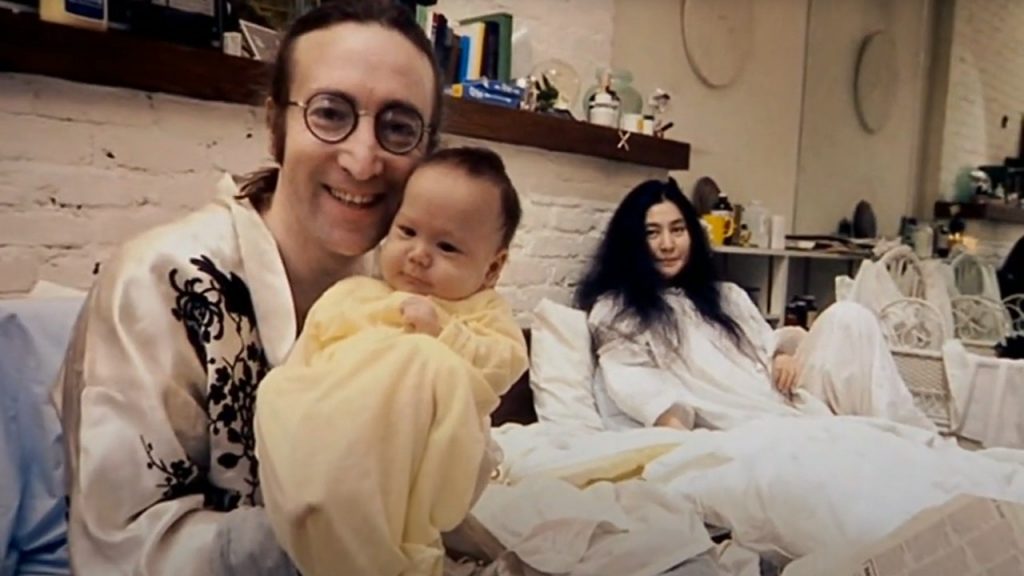
Photo Credit: The U.S. vs. John Lennon
Yoko Ono recalled, “I remember John’s face. I remember how he was when we got that news. It was his birthday and he got the baby, as well. It was incredible! I’d never seen him like that. He was like a little boy looking so happy.” John now had the freedom and opportunity to be the father he had always wished he’d had.
John’s Childhood
After both his parents had left, John Lennon had been raised by his Aunt Mary Smith, whom he called “Mimi.” His father, Alfred, had deserted John when he was very young. His mother, Julia, released John into her sister’s custody. John grew up surrounded by abandonment, anger and insecurity. “I was always in trouble.” John said, “Every school I went to, I was thrown out.”
From his formative years, John held doubt in all authority. This continued to prove itself throughout his life. Yet he managed to carve out messages of love, acceptance and peace in his songs.
Cynthia Powell Lennon
In the late 1950’s John met Cynthia Powell while attending art school. John and Cynthia were married in 1962. They welcomed their son, Julian Charles, a year later. The couple divorced in 1968.
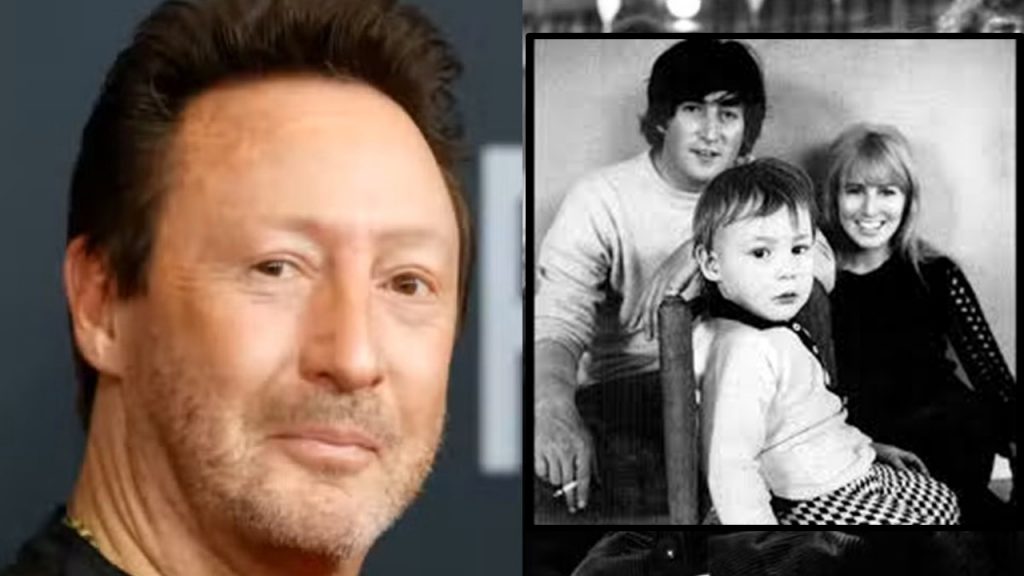
Cynthia Lennon continued loving John as she wrote two memoires: “A Twist of Lennon” in 1978 and “John” in 2005. She pursued an artistic career and married two more times. Cynthia had sold some of the letters John had written to her. Paul McCarney secretly purchased one, had it framed and returned it to Cynthia. She passed away from cancer in 2015 after living 75 years.
Julian Lennon has produced five albums. He has lived in New York City most of his life, but now resides in a small Italian town.
Yoko Ono
Yoko Ono and John met in 1966 at one of Yoko Ono’s art shows. It had been passion from the start. “With my presentation of performance art, I was always aware that I wanted to inspire people and stir people, so they can wake up.” Yoko Ono spoke of her exhibitions.
Yoko Ono’s daughter, Kyoko Chan Cox, born in 1963 in Japan, has grown up away from the spot light with her father, Anthony Cox, on a midwestern farm.
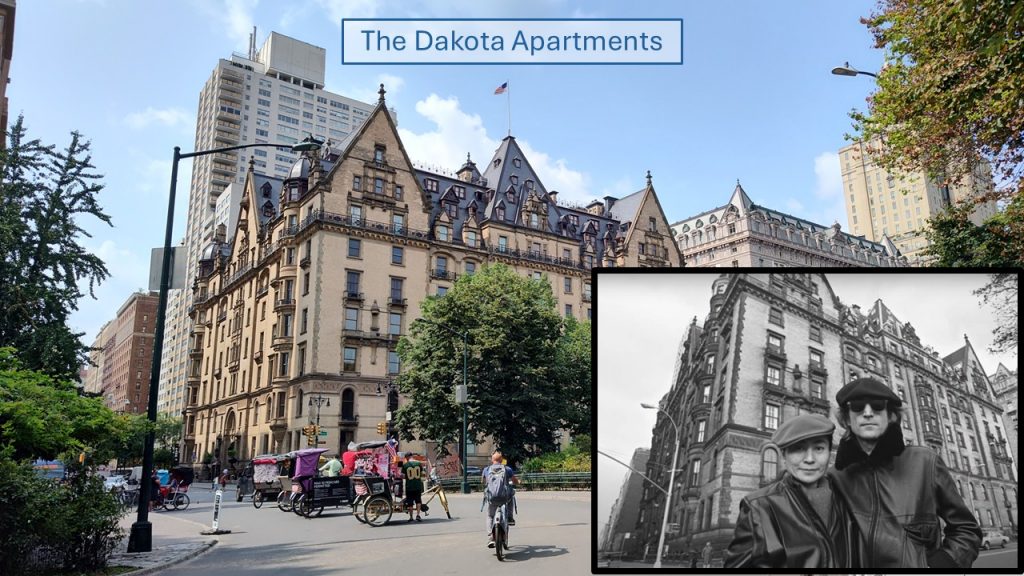
“We were totally and fearlessly rebellious people.” Yoko Ono had said. The pair complimented one another and married in 1969. Their honeymoon was a week in bed with a slogan “Bed Peace.” John encouraged people to “Give Peace A Chance.” John had once said, “Ghandi’s tried it. Martin Luther King has tried it. Both of them were shot. We haven’t given peace a complete chance.”
Sean Tara Ono Lennon
John and Yoko welcomed their son, Sean Tara Ono, born on John’s birthday, October 9, 1975.
John stepped out of the music business for five years to raise their son, Sean.

While Sean was a toddler, John had been quietly working on plans for a new album, “Double Fantasy” and even a concert tour. In 1980 as Sean turned five, John had been preparing to re-enter the music industry with the November release of his new album.
John Lennon’s Murder
Tragically, less than a month after his new album was released, on December 8, 1980, John’s life was cut short by four bullets in his back. He had been walking outside his apartment building just before
11:00 pm.
Yoko Ono spoke slowly, remembering the gatherings after John’s death, “I think the visual was a very good thing that we did. Um. ” She paused. “It was all of us around the world . . . came together in a way.” Emotion caught in her throat. “So, we made a ring around the world together. Yeah. It was a very strong ring.”
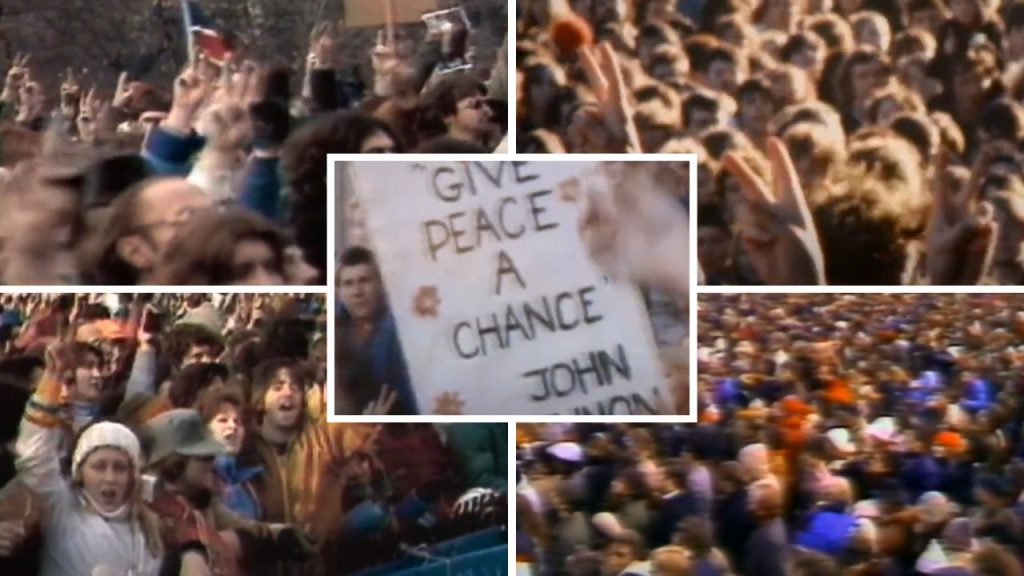
Photo Credit: The U.S. vs John Lennon Documentary
Yoko Ono looked over her glasses and nodded. “Well, they tried to kill John, but they couldn’t. His message is still alive.”
Strawberry Fields
Just four months after John’s tragic death, the New York City Council designated 2.5 acres of Central Park as “Strawberry Fields.” This area was named for one of John’s songs, “Strawberry Fields Forever,” which had been inspired by a Salvation Army children’s home near Liverpool where John had played as a boy.
Yoko Ono donated over a million dollars to construct this shrine. She visits the “Imagine” mosaic which is a block from their New York City apartment, where Yoko Ono still resides.
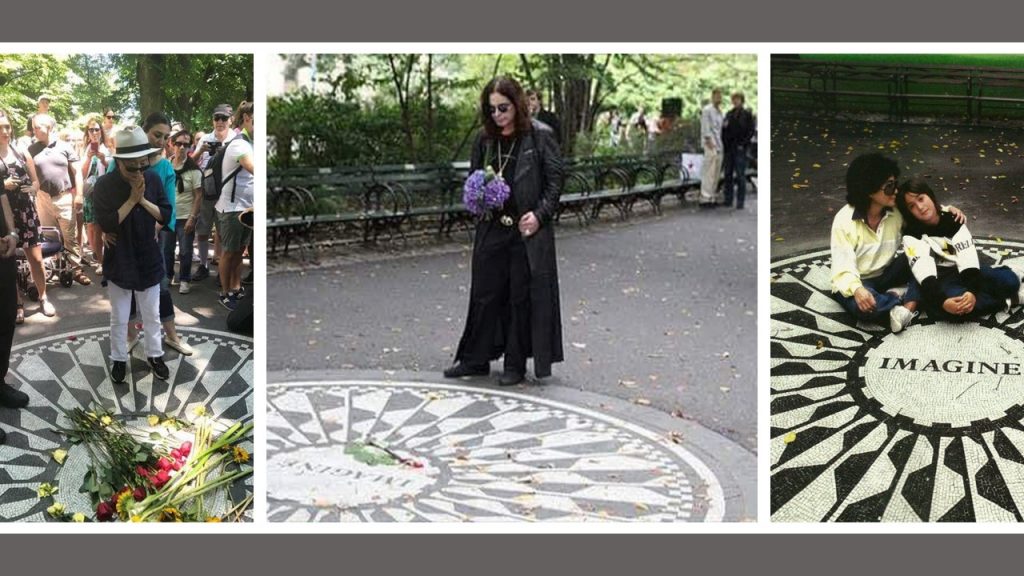
Yoko Ono and their son, Sean, have visited Central Park’s “Imagine” mosaic.
Our Visit To Strawberry Fields
Like a fine tapestry, my childhood memories are woven through the songs written by John Lennon. My FUNcle Bob, who had a fringed leather jacket, just like John Lennon’s, orchestrated antics in our paneled basement with orange shag carpeting while The Beatles blared from our plastic record player. FUNcle Bob, who was only ten years older than me, recently passed away and is missed terribly. So, when Chuck and I were in New York City, one stop I wanted to make was Strawberry Fields.
Chuck generously hired a horse drawn carriage for a tour through the iconic park. After seeing many sights, I heard music lofting from behind the trees. Our horse’s hooves clomped in time with the tune. As we approached I could distinctly hear through the rustling foliage, “Let It Be,” one of FUNcle Bob’s favorites.

“Oh, this is it!” I shook Chuck’s knee. The driver, Martin, pulled our carriage to a stop. “You can get out and see it, if you like.” His Irish baroque lilted with the melody.

A sanctuary of serenity surrounded a mosaic design. It was as if a dome had encapsulated this shrine, blocking out the bustle of New York City. The air felt pure as I inhaled, like the awaking one gets from an Altoid mint, alerting all my senses.
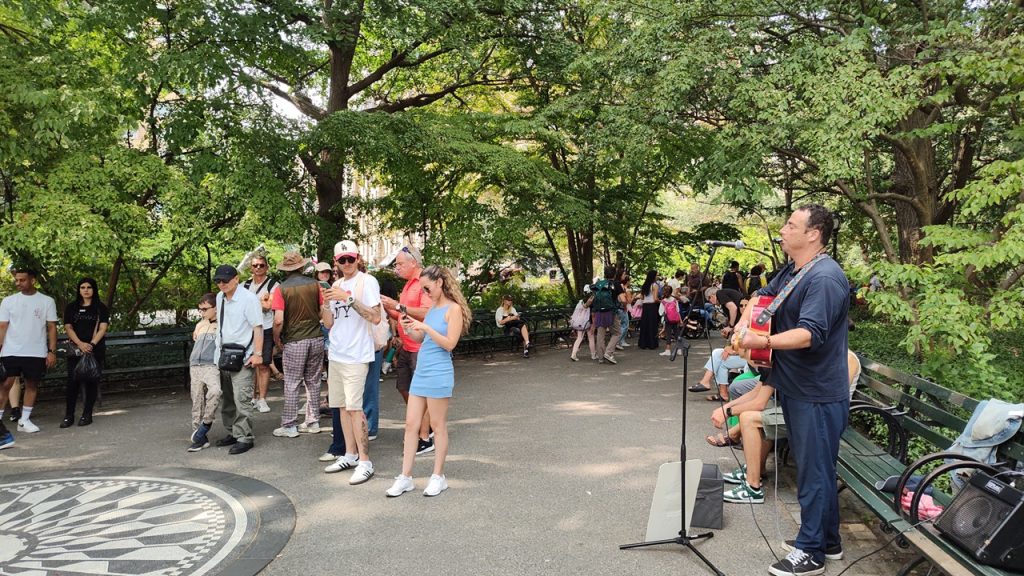
My shoulders relaxed as I sat on the bench, soaking in this moment, flipping through memories in my mind and feeling the power of John Lennon’s message, which still impacts our culture today. The musician began playing “Let me take you down, cause I’m going to Strawberry Fields . . .” Uncle Bob would have loved this!
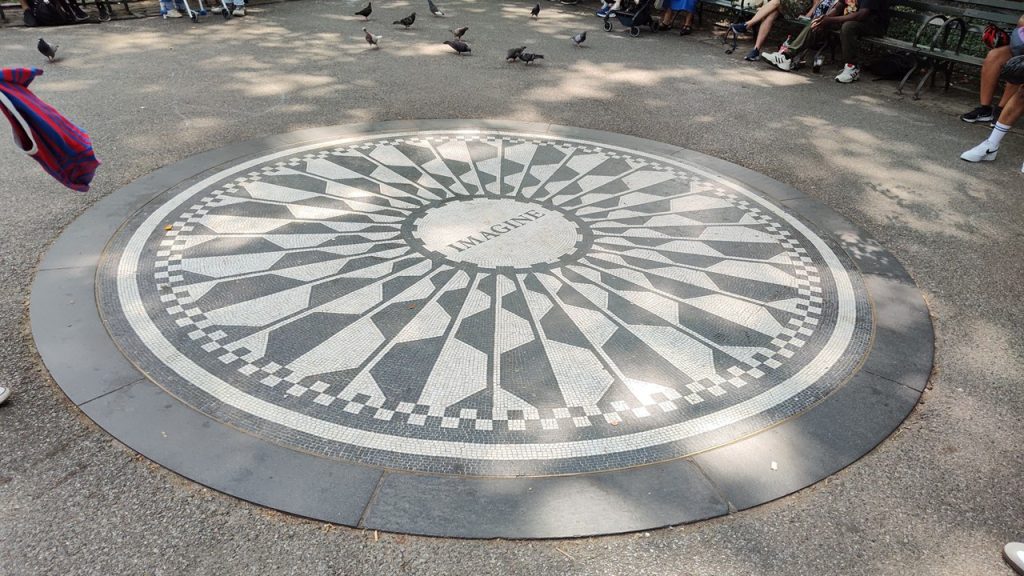
An energy of peace radiated and I inhaled hope in it’s finest form before returning to the carriage.
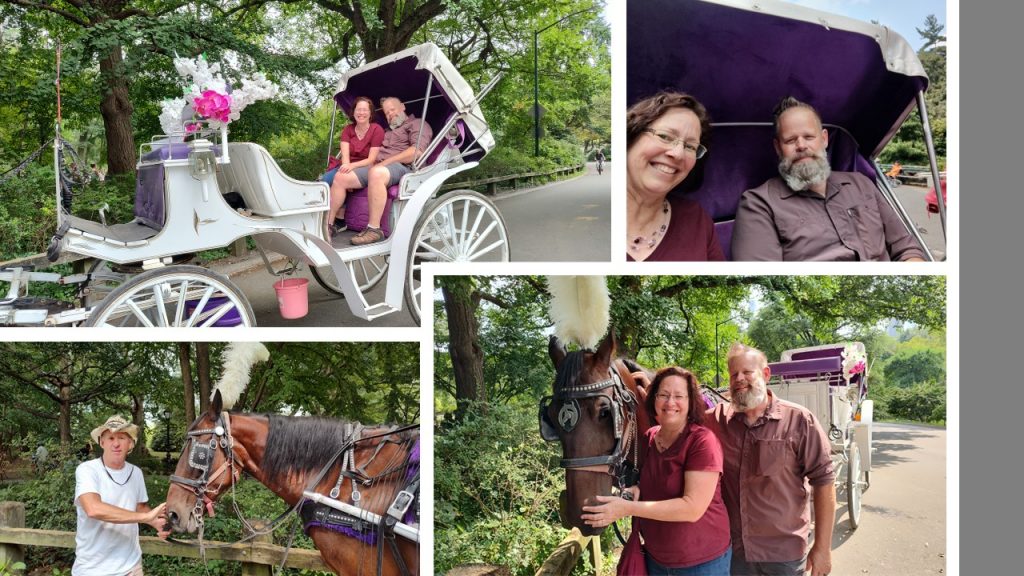
I have renewed hope in the people of our country to once again make our voices heard. Our nation’s symbol, an eagle, needs both its right and left wings to soar.
Resources:
On This Day article
Reddit photo of Ozzy Osbourne
Think Museum’s YouTube channel
The Independent article July 21, 2022
Marcia Scheider’s Facebook post
“The U.S. vs John Lennon” documentary
Pinterest site


